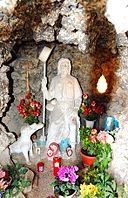
San Rocco patron of Sarmato
history of the saint who scored markedly Christianity in Sarmato
The history of San Rocco, his holiness, his experiences in Sarmato spread throughout Christendom by the pilgrims who were standing here.
In the country are still preserved the fountain and the house called St. Rocco, along the line of springs, the church and the cave of St. Rocco.
The presence of the Holy in Sarmato is certain, as is also recognized by the most severe criticism recently.
The patron saint of the Holy Sarmatesi is a young man who has dedicated, as is known, his life to the care of plague victims in many places and in Piacenza, where he contracted the disease.
Repaired at Sarmato miraculously escaped the plague and here history and legend are intertwined: the intervention of an angel comforter, a miraculous rain, with the formation of a provident fountain, dog wearing a loaf, the encounter with Count Gottardo, the conversion of the latter, the foundation of a monastery, his departure to France, the promotion of his Holiness by the Gotthard, the pear tree miraculously popped from his stick.
The sarmatesi, grateful for the protection of the saint, transformed his hut in the chapel; in the sixteenth century. rose up a small church in the next century had final touches: a single nave and the façade, which in the pre-war period was covered with a fifth neoclassical. inside is preserved a valuable Baroque statue of the saint, particularly loyal to traditional iconography.
A story related to the tree of pears and San Rocco is the kidnapping, still present in the memory of some sarmatesi family, a young man named Gertrude, daughter of a blacksmith shop near the oratory.
A count Scotti had noticed her beauty and never missed an opportunity to be on its way: the young man has tried in vain to pass unnoticed, trascurandosi in dress and in the cleaning of the face, but on a Sunday morning on the trail that linked the church oratory, was taken by force by some thugs and taken to the castle.
After some time he was thrown from a window instead of servants drunk from the well of the cut, as ordered by the count, saving himself and miraculously repaired at his home where he lived hidden in the attic for 14 years until the death of his tormentor.
At this event occurring in the late fifteenth century, seems tied the drying up of the miraculous but, already born from the stick of San Rocco, which gave pleasant fruits and effective against all kinds of disease.
In the country are still preserved the fountain and the house called St. Rocco, along the line of springs, the church and the cave of St. Rocco.
The presence of the Holy in Sarmato is certain, as is also recognized by the most severe criticism recently.
The patron saint of the Holy Sarmatesi is a young man who has dedicated, as is known, his life to the care of plague victims in many places and in Piacenza, where he contracted the disease.
Repaired at Sarmato miraculously escaped the plague and here history and legend are intertwined: the intervention of an angel comforter, a miraculous rain, with the formation of a provident fountain, dog wearing a loaf, the encounter with Count Gottardo, the conversion of the latter, the foundation of a monastery, his departure to France, the promotion of his Holiness by the Gotthard, the pear tree miraculously popped from his stick.
The sarmatesi, grateful for the protection of the saint, transformed his hut in the chapel; in the sixteenth century. rose up a small church in the next century had final touches: a single nave and the façade, which in the pre-war period was covered with a fifth neoclassical. inside is preserved a valuable Baroque statue of the saint, particularly loyal to traditional iconography.
A story related to the tree of pears and San Rocco is the kidnapping, still present in the memory of some sarmatesi family, a young man named Gertrude, daughter of a blacksmith shop near the oratory.
A count Scotti had noticed her beauty and never missed an opportunity to be on its way: the young man has tried in vain to pass unnoticed, trascurandosi in dress and in the cleaning of the face, but on a Sunday morning on the trail that linked the church oratory, was taken by force by some thugs and taken to the castle.
After some time he was thrown from a window instead of servants drunk from the well of the cut, as ordered by the count, saving himself and miraculously repaired at his home where he lived hidden in the attic for 14 years until the death of his tormentor.
At this event occurring in the late fifteenth century, seems tied the drying up of the miraculous but, already born from the stick of San Rocco, which gave pleasant fruits and effective against all kinds of disease.
-
Search
-
Categories
- Farmhouses
- Farmhouse in Piacenza and province
- Autumn/Winter Piacentino
- Ferragosto 2105 in Agriturismo
- Restaurants
- Visit Piacentino
- Piacenza Museums
- Castello di Rivalta
- Excursions in the Province of Piacenza
- Recipes Piacentine
- Wines Piacentini
- Typical Products Piacentini
- Events in Piacentino
- Illustrious Piacentini
- Art Piacentina
- library Piacenza
- Photogallery from Piacentino
- Contacts
- Download App
- Mangiare Piacentino
- holiday packages
-
Topics
- Art and Artists Piacentini
- Cooking and traditions
- Illustrious Piacentini
- castle of Rivalta
- Christmas and New Year in Farms
- Valentine in Farms
- Ferragosto in Farms
- Eating in Piacentino
- Farms in Emilia Romagna
- Common Piacentini advocates
- Events in Piacentino
- Emilia Romagna and its Traditions
- Tourism and Piacenza Province
- Routes in Piacenza
- Discipline in Emilia Romagna
- Freetime in Piacentino
- Videos and Movies
- Phoyogallery of Piacentino
- legend Symbols








